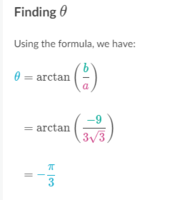You are using an out of date browser. It may not display this or other websites correctly.
You should upgrade or use an alternative browser.
You should upgrade or use an alternative browser.
Algebra of arctan identity
- Thread starter Lefiek
- Start date
D
Deleted member 4993
Guest
\(\displaystyle \frac{3}{\sqrt{3}} \ = \ \frac{\sqrt{3}\ \cdot \ \sqrt{3}}{\sqrt{3}} \ = \ \sqrt{3}\)
Dr.Peterson
Elite Member
- Joined
- Nov 12, 2017
- Messages
- 16,102
I think you're asking about the trick of breaking up the 3 in order to cancel one factor. If you don't happen to see that, you can multiply the numerator and denominator by [MATH]\sqrt{3}[/MATH] and then cancel; that is a standard trick called "rationalizing the denominator". Both forms can be very useful.Side question: how do you visualize the squares like that? It seems like a very useful tool.
When you have an expression that is hard to work with, two standard techniques for making life easier areThank you - as I feared and suspected, the answer was obvious.
Side question: how do you visualize the squares like that? It seems like a very useful tool.
[MATH]a = a + 0 = a + b - b = (a + b) - b[/MATH]
and [MATH]a = a * 1 = a * \dfrac{b}{b} = \dfrac{ab}{b}\text { with } b \ne 0.[/MATH]
The hard part is seeing what b to use.
What Subhotosh Khan showed you is called rationalizing the denominator. Before hand calculators, it was almost an essential skill.
[MATH]\dfrac{4}{\sqrt{7} - \sqrt{5}} = \dfrac{4}{\sqrt{7} - \sqrt{5}} * 1 = \\ \dfrac{4}{\sqrt{7} - \sqrt{5}} * \dfrac{\sqrt{7} + \sqrt{5}}{\sqrt{7} + \sqrt{5}} = \dfrac{4(\sqrt{7} + \sqrt{5})}{7 - 5} = 2(\sqrt{7} + \sqrt{5})[/MATH]

